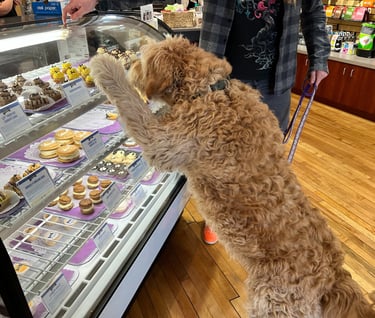A Brief How To: Canine Enrichment
The what and how for dog enrichment.
CANINE


The term ”Enrichment” refers to providing dogs with activities and environments that mimic their natural behaviors. Enrichment can include activities such as providing toys, puzzles, and training opportunities – as well as opportunities for socialization and exploration.
Enrichment is important for captive companion animals because it helps to keep them mentally and physically stimulated, which can reduce stress and boredom. Keeping your pets’ brains happy and healthy will lead to improved overall well-being, as well as a more positive relationship with their human family!
Here are a few ways to provide canine enrichment:
Exercise: Dogs need regular physical exercise to stay healthy and happy. Your dog might like activities such as going for walks, runs, or playing fetch.
Training: Training provides mental stimulation and helps to keep dogs' minds active. This can include obedience training, agility training, or other types of training that challenge the dog mentally.
Food puzzles: Provide your dog with food puzzles that encourage them to forage for their food, just like they would in the wild! You can also use treat-dispensing toys or hide small amounts of food around the house for them to find.
Environmental enrichment: Provide your dog with a varied and stimulating environment. Ideas include hiding toys or treats around the house and providing them with different textures and surfaces to explore, such as grass, sand, or water.
Socialization: Make sure your dog has plenty of opportunities to socialize with other dogs and people. Your dog's favorite form of socialization may be going to the dog park, but you can also try going on walks in the neighborhood or inviting friends over to visit.
Scent work: Dogs have a powerful sense of smell, and scent work can be a great way to provide mental stimulation. Training your dog to find specific scents can be a fun and challenging activity for them.
It's important to keep in mind that, just like people, every dog is different and may have different preferences. Always watch your pet’s behavior and adjust the enrichment accordingly.
Clicker training is a type of positive reinforcement training that uses a small, handheld device called a clicker to mark the exact moment a desired behavior is performed. This method of training is popular because it is highly effective, easy to use, and non-violent. Here is an overview of how to clicker train your dog to sit:
Get a clicker and a small bag of treats. You will use the clicker to mark the desired behavior and the treats to reward your dog.
Charge the clicker: Charge the clicker by clicking it and immediately giving your dog a treat. Do this several times until your dog starts to associate the click sound with getting a treat.
Position yourself in front of your dog and hold a treat in front of their nose. Slowly move the treat up and over their head, causing them to look up and sit down.
As soon as their hindquarters touch the ground, click the clicker and give them the treat. Repeat this several times, clicking and treating each time your dog sits.
Once your dog is consistently sitting when you move the treat over their head, start to add a verbal command, such as "sit." Say the command just before you move the treat over their head.
Gradually start to fade the use of the treat as a lure and start to use only the verbal command, clicking and treating only when your dog sits on command.
Practice in different environments and situations to generalize the behavior.
It's important to keep in mind that, like any training, it takes time and patience to teach a dog a new behavior. Clicker training is a positive reinforcement method, so it's important to be consistent and avoid using physical force or punishment. Additionally, make sure the training sessions are short and fun, and always end on a positive note.
